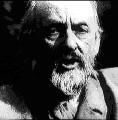
Home - Search - Browse - Alphabetic Index: 0- 1- 2- 3- 4- 5- 6- 7- 8- 9
A- B- C- D- E- F- G- H- I- J- K- L- M- N- O- P- Q- R- S- T- U- V- W- X- Y- Z
Tsiolkovskiy, Konstantin E
 Tsiolkovskiy |
Born: 1857. Died: 1935-09-19.
Konstantin E. Tsiolkovskiy became enthralled with the possibilities of interplanetary travel as a boy, and at age fourteen started independent study using books from his father's library on natural science and mathematics. He also developed a passion for invention, and constructed balloons, propelled carriages, and other instruments. To further his education, his parents sent young Tsiolkovskiy to Moscow to pursue technical studies.
In 1878, he became a teacher of mathematics in a school north of Moscow. Tsiolkovskiy first started writing on space in 1898, when he submitted for publication to the Russian journal, Nauchnoye Obozreniye (Science Review), a work based upon years of calculations that laid out many of the principles of modern space flight. The article, "Investigating Space with Rocket Devices," presented years of calculations that laid out many of the principles of modern space flight and opened the door to future writings on the subject. In it, Tsiolkovskiy described in depth the use of rockets for launching orbital space ships.
There followed a series of increasingly sophisticated studies on the technical aspects of space flight. In the 1920s and 1930s Tsiolkovskiy proved especially productive, publishing ten major works, elucidating the nature of bodies in orbit, developing scientific principles behind reaction vehicles, designing orbital space stations, and promoting interplanetary travel. He also furthered studies on many principles commonly used in rockets today: specific impulse to gauge engine performance, multistage boosters, fuel mixtures such as liquid hydrogen and liquid oxygen, the problems and possibilities inherent in microgravity, the promise of solar power, and spacesuits for extravehicular activity. Significantly, he never had the resources-nor perhaps the inclination-to experiment with rockets himself.
After the Bolshevik revolution of 1917 and the creation of the Soviet Union, Tsiolkovskiy was formally recognized for his accomplishments in the theory of space flight. Among other honors, in 1921 he received a lifetime pension from the state that allowed him to retire from teaching at the age of sixty-four. Thereafter he devoted full time to developing his space flight theories studies. He died at his home in Kaluga on 19 September 1935. His theoretical work greatly influenced later rocketeers both in his native land and throughout Europe. While less well known during his lifetime in the United States, Tsiolkovskiy's work enjoyed broad study in the 1950s and 1960s as Americans sought to understand how the Soviet Union had accomplished such unexpected success in its early efforts in space flight.
Country: Russia. Bibliography: 535.
 | Tsiolkovsky Poster |
1879 - .
- Tsiolkovskiy's Astronomical Drawings - . Nation: Russia. Related Persons: Tsiolkovskiy. While living in Ryazan with his father's family, he published his first known scientific work. It schematically depicted the Solar System and the distances between planets..
1883 - .
- Tsiolkovskiy's Free Space - .
Nation: Russia.
Related Persons: Tsiolkovskiy.
Tsiolkovsky considered the possibility of living in outer space and the effects of zero gravity. For the first time he included a drawing of a spacecraft that could orient itself in space with the help of reactive jets (but not change its position by propulsive rockets).
1903 - .
- Tsiolkovskiy's The Investigation of Space by Means of Reactive Devices - . Nation: Russia. Related Persons: Tsiolkovskiy. Here he first outlined his theory of spaceflight and published the basic equation for reaching space by rocket that is still known to students as the 'Tsiolkovsky Equation'. It was the first theoretical proof of the possibility of spaceflight..
1926 - .
- Tsiolkovskiy's Plan Of Space Exploration - .
Nation: Russia.
Related Persons: Tsiolkovskiy.
In this work he predicted the manned colonization of the universe in 16 phases:
1. Design of rocket-propelled airplanes with wings.
2. Progressively increasing the speeds and altitudes reached with these airplanes.
3. Designing of a pure rocket without wings.
4. Developing the ability to land on the ocean surface by rocket.
5. Reaching of escape velocity and first flight into space.
6. Lengthening of the rocket flight time into space.
7. Experimental use of plants to make an artificial atmosphere in spacecraft.
8. Using of pressurised space suits for activity outside spacecraft.
9. Making of orbital greenhouses for plants.
10. Building of the large orbital habitats around the earth.
11. Using solar radiation to grow food, to heat space quarters, and for transport needs throughout the solar system.
12. Colonization of the asteroid belt.
13. Colonisation of the entire solar system and beyond.
14. Achievement of individual and social perfection.
15. Overcrowding of the solar system and galaxy colonisation.
16. The sun begins to die and the people remaining in the solar system's population move to other solar systems.
1929 - .
- Tsiolkovskiy's Rocket Space Trains - . Nation: Russia. Related Persons: Tsiolkovskiy. In this work he suggested a method of reaching of escape velocity using a multistage booster..
1932 May 1 - .
- Tsiolkovskiy's last radio speech - . Nation: Russia. Related Persons: Tsiolkovskiy. He predicted that, using multistage boosters, the first space flights would take place within 20 to 30 years..
1935 September 19 - .
- Death of Konstantin E Tsiolkovskiy - . Nation: Russia. Related Persons: Tsiolkovskiy. Chief Soviet theorist of spaceflight, developed mathematics of rocketry and space travel, identifying basic rocket and spacecraft designs. But work little known outside the Soviet Union, did not influence Goddard and Oberth..
Back to top of page
Home - Search - Browse - Alphabetic Index: 0- 1- 2- 3- 4- 5- 6- 7- 8- 9
A- B- C- D- E- F- G- H- I- J- K- L- M- N- O- P- Q- R- S- T- U- V- W- X- Y- Z
© 1997-2019 Mark Wade - Contact
© / Conditions for Use